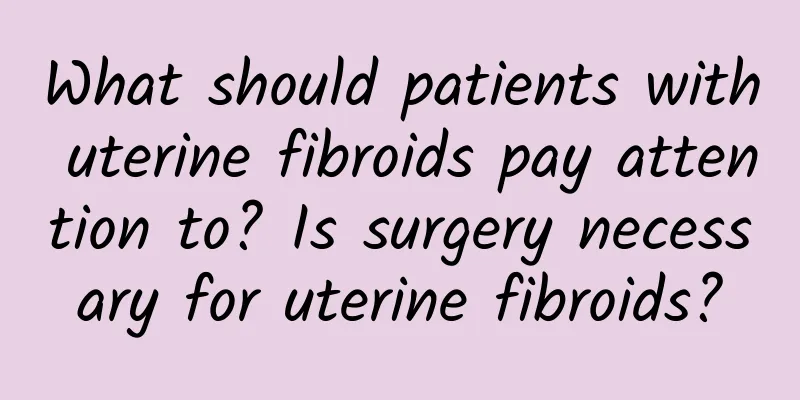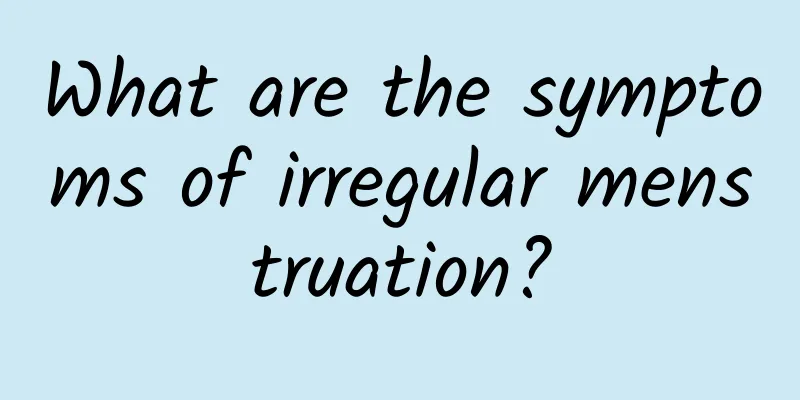What should patients with uterine fibroids pay attention to? Is surgery necessary for uterine fibroids?

|
For patients with myoma, the age for hysterectomy was set at over 45 years old in the past. Now it seems that, based on reality, especially according to the progress of gynecological endocrinology, the age for ovarian preservation is generally 50 years old (the average age of menopause is 49.5 years old), that is, under 50 years old, those who can preserve the ovaries should preserve them. Or normal ovaries that have not reached menopause after 50 years old should also be preserved, rather than age markers. Because normal ovaries still have certain endocrine functions after menopause, they must work for 5 to 10 years. Preserving the ovaries helps to hide the autonomic nerves, regulate metabolism, and facilitate the transition to the elderly. The uterus also has its endocrine function and is the target organ of the ovaries, so it should not be removed at will. Usually, the age for hysterectomy is over 45 years old, and those under 45 years old, especially those under 40 years old, are suitable for myomectomy. For those who retain the appendages, if both sides can be retained, it is best to retain both, rather than one side. The incidence of ovarian cancer is 0. Not higher than 15% of those who do not have their uterus removed. Uterine fibroid surgery patients must read Uterine fibroid surgery 1. Myomectomy: It is a surgery to remove the fibroids on the uterus and preserve the uterus. It is mainly used for women under 45 years old, especially those under 40 years old. This is not only a surgery for infertile women who have no children, but also for those who have children. The fibroids are large, with a diameter greater than 6cm; the menstrual period is too heavy, and conservative medication is ineffective; or there are compression symptoms; submucosal fibroids; fibroids grow faster. For the sake of physical and mental health, enucleation should also be performed. As for the number of fibroids, it is usually limited to 15 or less. There are also examples of those who are eager to have children, no matter how many, even more than 100, who have children after excavation. Before or after uterine fibroid surgery, in order to prevent the fibroids from growing again, you can take Qinghong Gongliuqing Tablets to prevent the fibroids from growing again. After abdominal uterine myoma resection, in order to prevent postoperative abdominal adhesion, the uterine incision should be the anterior wall, the incision should be as small as possible, and as much fibroids as possible should be removed from the incision. Penetration of the endometrium should also be avoided as much as possible. The incision should be completely hemostatic, and the incision should be sutured without leaving a dead cavity. The postoperative uterine incision should be peritonealized as much as possible. Submucosal fibroids can be removed vaginally, and excessive traction should be avoided during resection, and the uterine wall should not be damaged during resection. Unresected fibroids can also be removed through the abdomen. Postoperative treatment should give hemostatic drugs and antibiotics; non-pregnant women should take contraceptive measures for 1 to 2 years; future pregnancies should be alert to uterine rupture and placenta implantation, and full-term selective cesarean section. Recurrence may also occur after myomectomy, and regular examinations should be conducted. 2. Hysterectomy: It is expected that treatment and drug therapy will not improve the patient's symptoms, and the surgical staff is not qualified for myomectomy, so hysterectomy should be performed. Hysterectomy can choose total hysterectomy or vaginal hysterectomy. Hysterectomy is mainly abdominal, individual tumors are small, there is no inflammation and adhesion in the appendages, the abdominal wall is too fat, and abdominal wall eczema can be considered vaginal. The advantages of abdominal surgery are: the technical operation is simpler than vaginal surgery, with less bleeding; large fibroids and adnexal adhesions are also easy to handle. The disadvantage is that if the rectum and bladder are swollen and the vaginal wall is loose, a separate vaginal surgery is required. Anatomical variations of pelvic organs (ureters, bladder, rectum, large blood vessels, etc.) and complex cases such as ligament myomas cause serious anatomical variations and adhesions, which are difficult to expose during surgery and bring great difficulties to surgery. These problems can be referred to gynecological surgery. Large submucosal myomas cause severe anemia, and surgery (simple myomectomy or hysterectomy) is usually performed after blood transfusion improves the physical condition. However, in remote rural areas, sometimes there is a lack of blood sources, bleeding does not stop, it is not suitable for movement and walking, the cervix is open, and the myoma protrudes from the cervix or near the vaginal opening. The myoma should be removed through the vagina, which is usually more conducive to stopping bleeding and correcting the general situation. Hysterectomy is generally recommended, especially for those with cervical hypertrophy, laceration or severe erosion. However, if the patient is in poor general condition and the technical conditions are limited, subtotal hysterectomy can be performed, and the incidence of stump cancer is only about 1-4%. However, regular check-ups are still recommended after surgery. Patients with uterine fibroid surgery must recover after surgery 1. Wound care The wound of laparoscopy is usually 1 cm long at the navel and 0 cm long at the lower abdomen. A 5 cm wound, after surgery, a one cm wound is usually or simply sutured, at this time can be sutured with absorbable or non-absorbable sutures, if non-absorbable sutures are used, 7 days after surgery, if absorbable sutures are used, there is no need to remove the sutures; as for the 0.5 cm wound, it can be taped with breathable tape, but sometimes in order to increase the neatness of wound healing, stitches and simple sutures can also be used. For the care of these wounds, before showering or getting wet, care should be taken to keep the wound clean, dry, and other wounds completely healed (about 10 days). Most importantly, since the number of days of hospitalization for laparoscopic patients is very short, patients must pay attention to whether the wound is red, swollen, hot, and painful every day after returning home to prevent infection and inflammation. However, inflammation of the wound after laparoscopic surgery is quite rare. 2. Vaginal bleeding In order to clearly examine the ovaries, fallopian tubes, and the back of the uterus or provide enough space for surgery, a uterine support device is usually placed through the vagina (not necessary for unmarried women) to adjust the position of the uterus, so there will be a small amount of vaginal bleeding after surgery, which is normal, but if the vaginal bleeding exceeds two weeks, please consult a doctor to see if there is any abnormality. As for patients who undergo laparoscopic hysterectomy, since the top of the vagina will be sutured after hysterectomy, brown bleeding within two weeks is still normal. It should be noted that if you walk or carry heavy objects within 8 weeks, it is easy to cause poor wound healing and cause bleeding from the stump, so it should be avoided. 3. Daily life Maintaining a comfortable life and doing a little exercise will help physical recovery. Patients who have undergone laparoscopic fallopian tube surgery and laparoscopic ovarian surgery should resume normal work and rest two weeks after surgery. Patients who have undergone total hysterectomy, except in the early stage of surgery (within two weeks), should avoid riding horses, cycling, sitting for long periods of time, and avoid pelvic congestion and postoperative discomfort. Pay special attention to avoid lifting objects over 5 kg or increasing the burden on the abdomen. After 8 weeks, gradually increase the amount of exercise according to personal physical strength and constitution to reduce the temporary reduction in pelvic support and the discomfort caused in the future. 4. Nutritional intake In principle, the nutritional intake after surgery is the same. We should drink more water to replenish the loss of body fluids during surgery. Usually, you should be able to resume eating after laparoscopic surgery. First, drink some warm water. If there is no discomfort, you can start to eat liquid food (such as porridge), and you can resume normal diet the next day. Since protein is needed for wound healing, you should eat high-protein foods (such as fish, lean meat and eggs)…. . ), in order to accelerate wound healing, avoid irritating foods, so as not to stimulate gastric acid secretion and cause gastrointestinal discomfort (such as pepper, smoke, oil, coffee). The biggest difference between laparoscopic surgery and general abdominal surgery is that since the operation requires the injection of carbon dioxide, the abdominal operation is convenient, and there is a tendency for residual carbon dioxide gas to remain after surgery, so the intake of vegetables and high-fiber fruits should be increased after surgery, and gas foods such as sweet potatoes, beans, onions…. Etc. can be avoided, so as to reduce the discomfort caused by abdominal distension after surgery. As for larger surgeries, such as hysterectomy, intestinal adhesion reduction, cervical cancer eradication surgery, etc., due to the long anesthesia time, long operation time, gastrointestinal absorption of more gas, easy abdominal distension, it is more appropriate to eat after 24 hours. For patients with postoperative nausea, vomiting, and special physical conditions, there is no need to force themselves to eat, and they can eat after the anesthesia completely subsides. |
Recommend
Will cervical erosion after pregnancy cause leucorrhea to turn brown?
Whether before or during pregnancy, you may find ...
Why do I bleed again just a few days after my period? Here is the answer
If this happens between two periods and the amoun...
How to treat cervical erosion?
The incidence of cervical erosion is now rising, ...
My period has lasted for more than 10 days. What should I do?
My period has lasted for more than 10 days. What ...
Beware of these causes of cervical erosion
Cervical erosion is also a common cervical diseas...
How to prevent irregular menstruation?
How to prevent irregular menstruation? To prevent...
What should I do if I have back pain during menstruation? Never hit your waist
Some women often experience back pain during or b...
What are the common manifestations of patients with cervical erosion? Clinical symptoms of patients with cervical erosion
What are the symptoms of cervical erosion? Cervic...
What causes cervicitis?
The treatment of cervicitis should be based on th...
What are the main things to pay attention to after abortion?
There are three main things to pay attention to a...
What is the common sense of ovarian cysts?
What is the common sense about ovarian cysts? Sym...
Experts answer: Does mild cervical hypertrophy require treatment?
Many people are at a loss as to what to do after ...
What are the diagnostic criteria for vaginitis?
What are the diagnostic criteria for vaginitis? W...
I have thick legs and a big butt and can’t lose weight? "Muscle Girl" Promotes Slimming Tea
Why do some people have "slim waist, plump b...
Is there a mass in the right abdomen of a female with pelvic effusion?
Pelvic effusion may cause a mass in the right abd...









